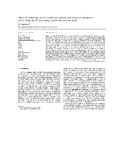Effect of annealing on the structural, optical and electrical properties of ITO films by RF sputtering under low vacuum level

View/
Date
2008Author
Sathiaraj, T.S.
Publisher
Elsevier Science Ltd. http://www.elsevier.com/locate/mejoType
Published ArticleMetadata
Show full item recordAbstract
Indium tin oxide (ITO) thin films were prepared by RF sputtering of ceramic ITO target in pure argon atmosphere at a high base pressure of 3×10−4 mbar without substrate heating and oxygen admittance. The use of pure argon during deposition resulted in films with high transparency (80–85%) in the visible and IR wavelength region. The films were subsequently annealed in air in the temperature range 100–400 °C. The annealed films show decreased transmittance in the IR region and decreased resistivity. The films were characterized by electron microscopy, spectrophotometry and XRD. The predominant orientation of the films is (2 2 2) instead of (4 0 0). The transmission and reflection spectra in the wavelength range 300–2500 nm are used to study the optical behaviour of the films. The optical transmittance and reflectance spectra of the films were simultaneously simulated with different dielectric function models. The best fit of the spectrophotometric data was obtained using the frequency-dependent damping constant in the Drude model coupled with the Bruggeman effective medium theory for the surface roughness. It has been found that the sputtering power and the chamber residual pressure play a key role in the resulting optical properties. This paper presents the refractive index profile, the structure determined from the XRD and the electrical properties of ITO films. It has been found from the electrical measurement that films sputtered at 200 W power and subsequently annealed at 400 °C have a sheet resistance of 80 Ω/□ and resistivity of 1.9×10−3 Ωcm.
